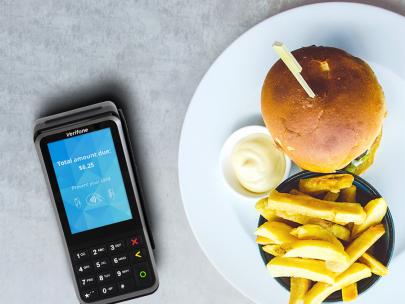We’re at an inflection point in physical retail experiences, and 2019 was a turning point. For the first time in five years same-store sales are stable (versus declining)1, break-out e-commerce brands continue to solidify their positions of growth by opening physical stores2, and success stories like Target, which invested $7BN in 2017 into capital improvements3, are encouraging other retailers like Ulta, Home Depot, and more to follow suit4.
So, now that it’s come to it, what do you do to reinvigorate your stores? Many times when we sit down with retail executive teams considering building out the future of their store fleets, the words on the board begin to look like a TechCrunch word cloud. “AR, VR, Chatbots, A.I., Drones!”.
But the reality should be different. When considering deploying retail technology such as self-service kiosks, decisions should center around one singular ideology: human interactions have to come first, and technology should support and enhance those interactions. And, technology should beautifully integrate into authentic store experiences. Consumer expectations are still out-pacing a lot of the retail experience of today. The retail market itself is on the cusp of massive change as it sprints to meet these demands. In this article, discover ways to thoughtfully execute retail-technology solutions that enable experiences that delight customers, empower associates, provide unprecedented analytics, and measurable sales growth.
Next Gen Consumers By The Numbers
According to data collected from the IBM Survey and Kiosk Marketplace Surveys, this is what your digital-first consumer looks like today, and these numbers are only increasing. Eighty-eight percent (88%) of retail customers expect digital engagement. Sixty-One Percent (61%) of consumers are willing to shop in a completely automated store. Seventy-eight percent (78%) of customers say their experiences using an automated service was positive. And fifty-two percent (52%) of consumers indicated that they prefer self-service checkout.
Stores Cannot Compete Like They Used To.
If you look at an image of a department store in 1910 vs. a department store today, not a whole lot has changed. In the mid-1900s, retail growth was booming. Topline revenue was driven by opening more and more stores with huge selections, huge square footage, great prices, and relative proximity to the customer. Proximity, selection, and price were the currency of the mid-century retailer.
As a result, we now have anywhere from 25-29 square feet of retail space per every man, woman, and child in the United States. The next closest country is the United Kingdom with 9 square feet per capita. Today’s stores are competing on a very different set of principles. According to MasterCard, over 40% of soft-goods purchasing takes place at boutique stores with 5-10 locations. As such, today’s currency is now experience, service, and urgency. And all of that retail space built in the last century? We now have an opportunity to use it in creative ways with a small footprint and low overhead.
Physical Retail Complements Online Retail
Online retail today continues to accelerate. It proves challenging for executives determining where to invest (e.g. vs. brick-and-mortar stores) largely because there is almost absolute attribution in eCommerce where most stores are data-starved. For example, if you’re a soft-goods retailer with 25% conversion of store traffic, that means 75% of customers walking through your store are absolute mysteries. If they go shopping online later, how do you possibly know that the in-store experience was a part of that journey? But this doesn’t mean the future is purely online, it just means the role of physical retail stores has shifted. When the best-known eCommerce brands start doing well, what do they start doing? They open up stores. Warby Parker, Bonobos, Cuyana, ModCloth, even Amazon and Alibaba, ALL opening up stores at a rapid pace.
Retail has morphed into a packaged deal inclusive of Online and Offline components. Successful brands realize that they need to cater to all shoppers, not only online ones. Physical retail shoppers combined with online shoppers equals huge growth channels, and retailers who span both channels come out ahead with CLV’s (Customer Lifetime Value). Customers from across all generations still prefer to try products before buying them. “Traditional” online retailers have recognized that the try-before-buy trend can be an opportunity. As and example, stores like Bonobos have opened Guide Shops which are specifically meant for try before you buy. When Bonobos did this, their customer base and basket sizes grew. The perfect blend of online and offline comes when retailers like Bonobos drive physical traffic in their stores and leverage their online-first. This inventory flexibility removes huge pain-points bogging down the traditional retail model – inventory accuracy, back-of-house allocation vs. front-of-house, and staff dedicated to “tidying up” vs. selling. While no model is perfect, these examples of the broader concept, dynamic fulfillment continues to be a huge driver of efficiency and growth in the retail sector. And as consumers gravitate towards more compelling experiences, other retailers are offering boutique selections in-store, leveraging high-touch experiences, and using inventory scarcity as an advantage (get it now or it's gone forever).
_white_rgb.png)




